Слайд 2

Equivalence
Translation equivalence (TE) is the key idea of translation.
Equivalent means equal
in value, amount, volume, etc. (A.S.Hornby)
Слайд 3

Equivalence
Equivalence is the central issue in translation.
Its definition, relevance, and
applicability within the field of translation theory have caused heated controversy.
Many different theories of the concept of equivalence have been elaborated within this field for the past fifty years.
Слайд 4

Equivalence
The most innovative theorists (Vinay and Darbelnet, Jakobson, Nida and Taber,
Catford, House, and finally Baker) have studied equivalence in relation to the translation process, using different approaches.
Слайд 5
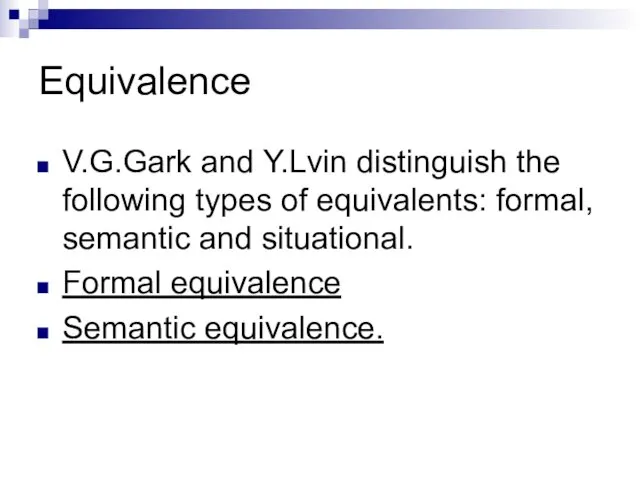
Equivalence
V.G.Gark and Y.Lvin distinguish the following types of equivalents: formal, semantic
and situational.
Formal equivalence
Semantic equivalence.
Слайд 6
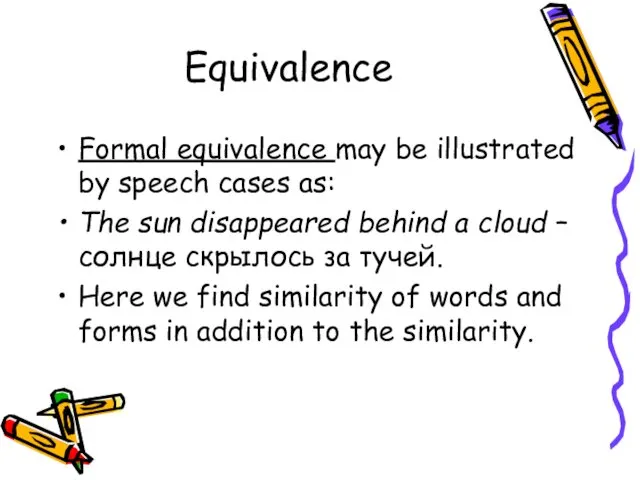
Equivalence
Formal equivalence may be illustrated by speech cases as:
The sun
disappeared behind a cloud – солнце скрылось за тучей.
Here we find similarity of words and forms in addition to the similarity.
Слайд 7
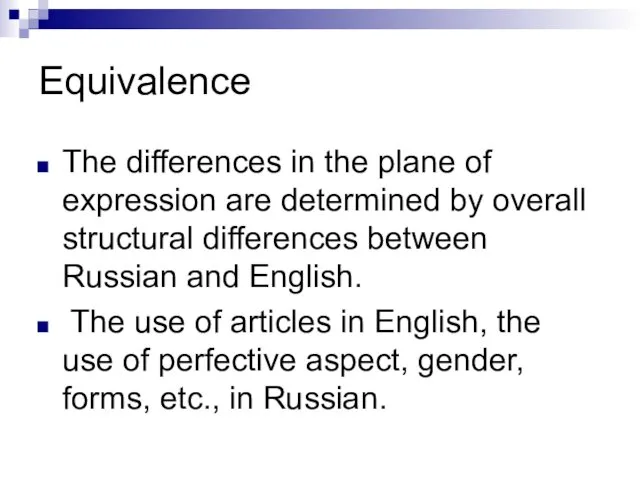
Equivalence
The differences in the plane of expression are determined by overall
structural differences between Russian and English.
The use of articles in English, the use of perfective aspect, gender, forms, etc., in Russian.
Слайд 8
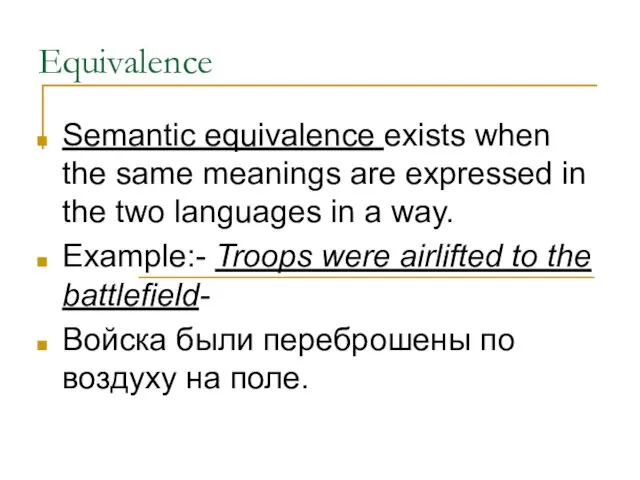
Equivalence
Semantic equivalence exists when the same meanings are expressed in the
two languages in a way.
Example:- Troops were airlifted to the battlefield-
Bойска были переброшены по воздуху на поле.
Слайд 9
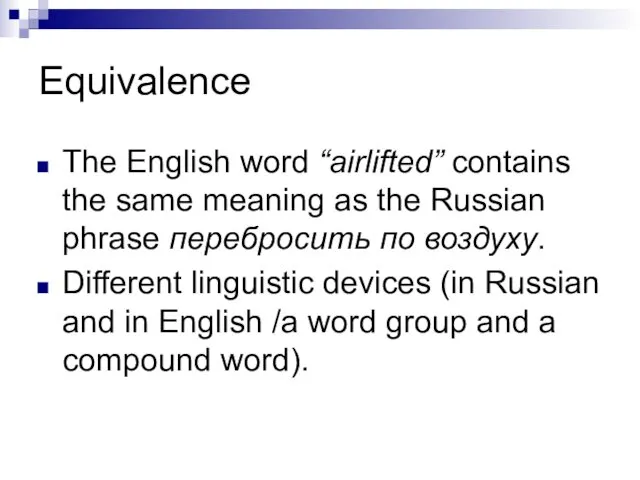
Equivalence
The English word “airlifted” contains the same meaning as the Russian
phrase перебросить по воздуху.
Different linguistic devices (in Russian and in English /a word group and a compound word).
Слайд 10
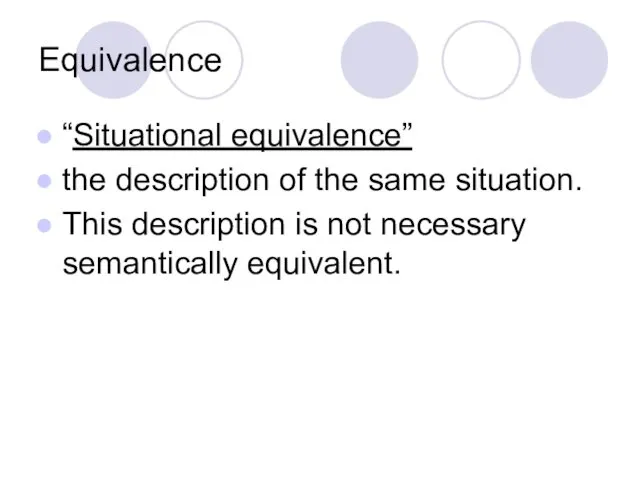
Equivalence
“Situational equivalence”
the description of the same situation.
This description is
not necessary semantically equivalent.
Слайд 11
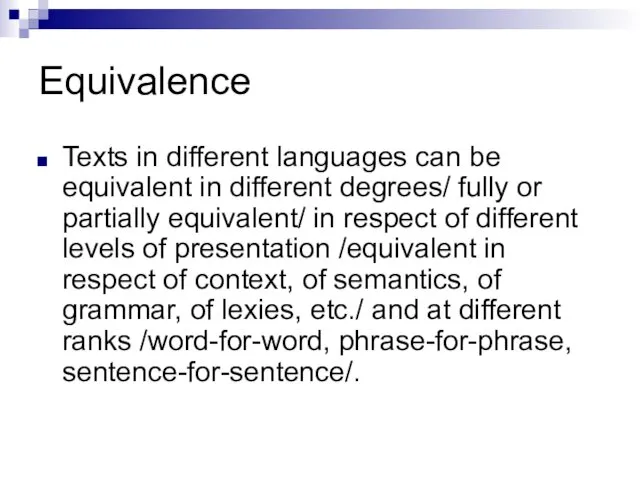
Equivalence
Texts in different languages can be equivalent in different degrees/ fully
or partially equivalent/ in respect of different levels of presentation /equivalent in respect of context, of semantics, of grammar, of lexies, etc./ and at different ranks /word-for-word, phrase-for-phrase, sentence-for-sentence/.
Слайд 12
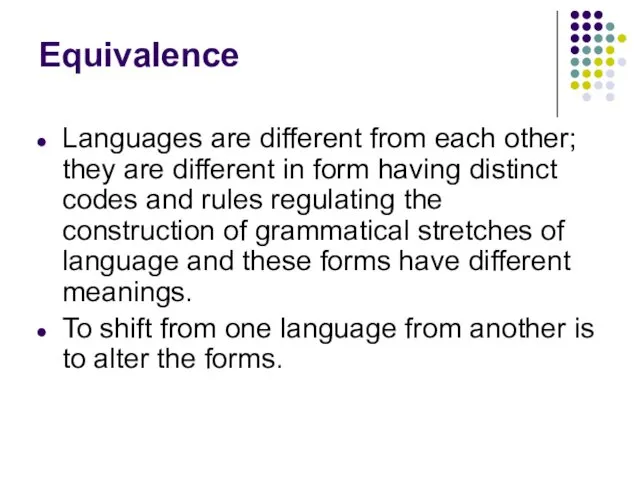
Equivalence
Languages are different from each other; they are different in form
having distinct codes and rules regulating the construction of grammatical stretches of language and these forms have different meanings.
To shift from one language from another is to alter the forms.
Слайд 13
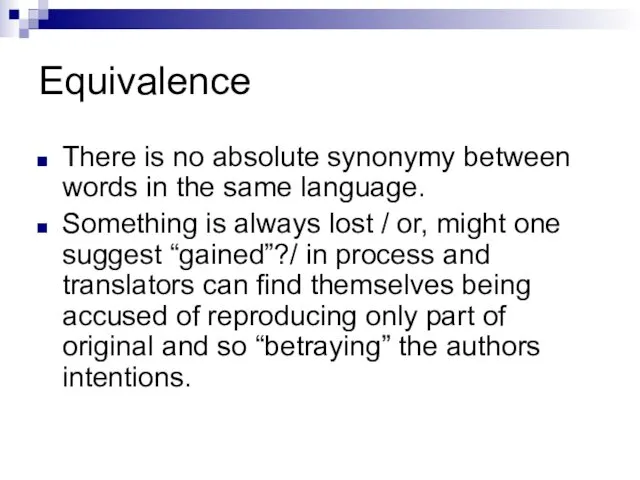
Equivalence
There is no absolute synonymy between words in the same language.
Something is always lost / or, might one suggest “gained”?/ in process and translators can find themselves being accused of reproducing only part of original and so “betraying” the authors intentions.
Слайд 14
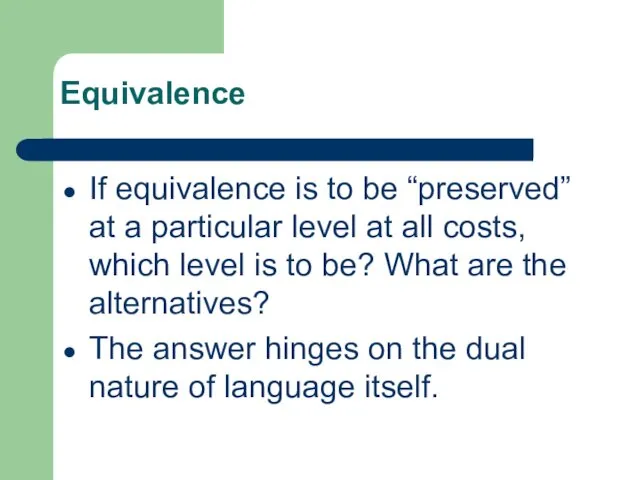
Equivalence
If equivalence is to be “preserved” at a particular level at
all costs, which level is to be? What are the alternatives?
The answer hinges on the dual nature of language itself.
Слайд 15
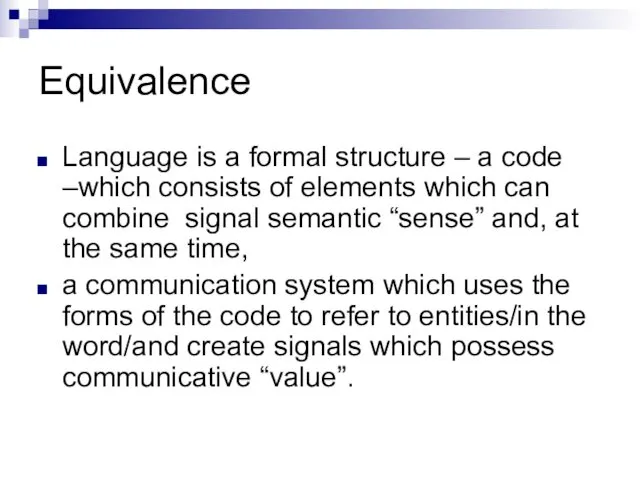
Equivalence
Language is a formal structure – a code –which consists of
elements which can combine signal semantic “sense” and, at the same time,
a communication system which uses the forms of the code to refer to entities/in the word/and create signals which possess communicative “value”.
Слайд 16

Adequacy
The notion of “adequacy” is closely connected with that of
equivalence.
Some scholars identify these terms and use them as completely interchangeable notions.
For example:
Слайд 17
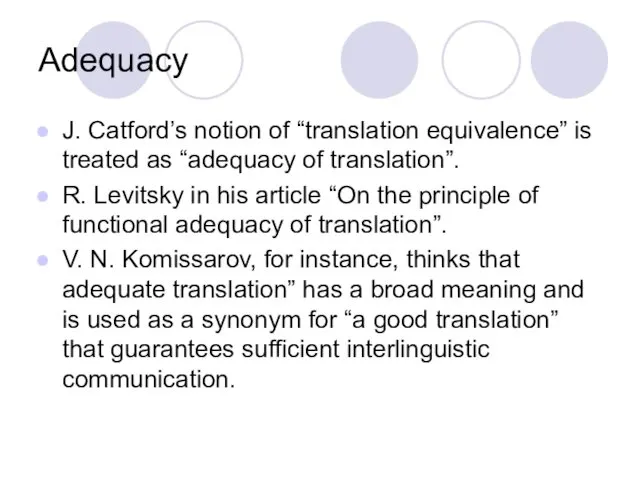
Adequacy
J. Catford’s notion of “translation equivalence” is treated as “adequacy of
translation”.
R. Levitsky in his article “On the principle of functional adequacy of translation”.
V. N. Komissarov, for instance, thinks that adequate translation” has a broad meaning and is used as a synonym for “a good translation” that guarantees sufficient interlinguistic communication.
Слайд 18
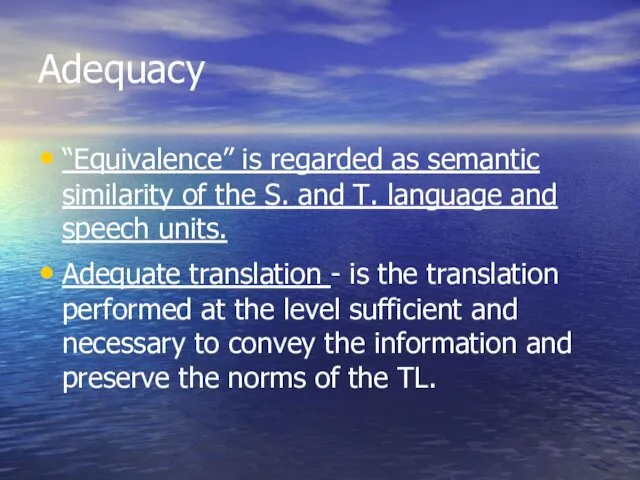
Adequacy
“Equivalence” is regarded as semantic similarity of the S. and T.
language and speech units.
Adequate translation - is the translation performed at the level sufficient and necessary to convey the information and preserve the norms of the TL.
Слайд 19
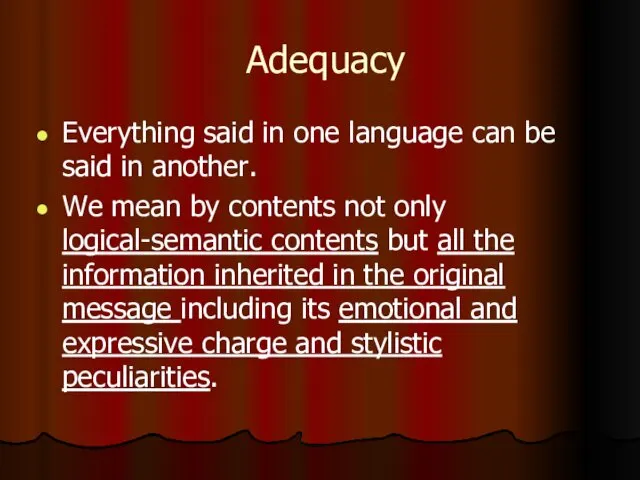
Adequacy
Everything said in one language can be said in another.
We
mean by contents not only logical-semantic contents but all the information inherited in the original message including its emotional and expressive charge and stylistic peculiarities.
Слайд 20
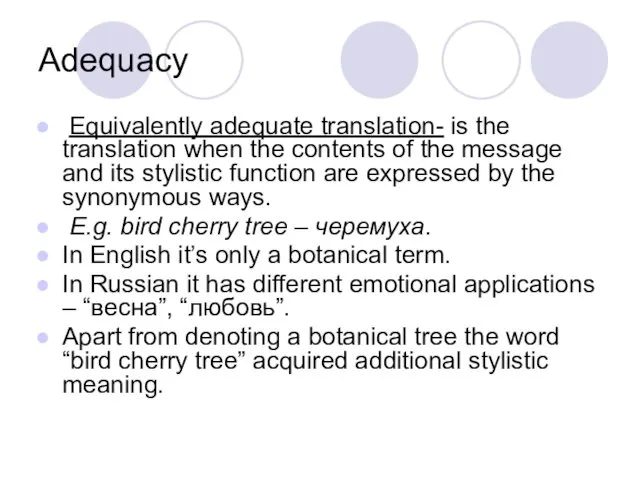
Adequacy
Equivalently adequate translation- is the translation when the contents of
the message and its stylistic function are expressed by the synonymous ways.
E.g. bird cherry tree – черемуха.
In English it’s only a botanical term.
In Russian it has different emotional applications – “весна”, “любовь”.
Apart from denoting a botanical tree the word “bird cherry tree” acquired additional stylistic meaning.
Слайд 21
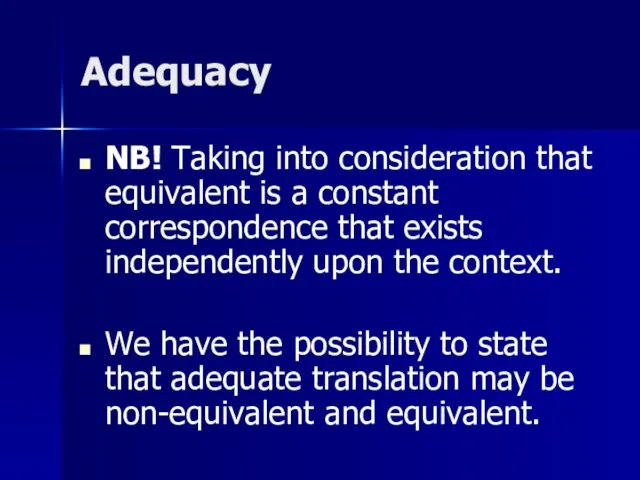
Adequacy
NB! Taking into consideration that equivalent is a constant correspondence that
exists independently upon the context.
We have the possibility to state that adequate translation may be non-equivalent and equivalent.
Слайд 22
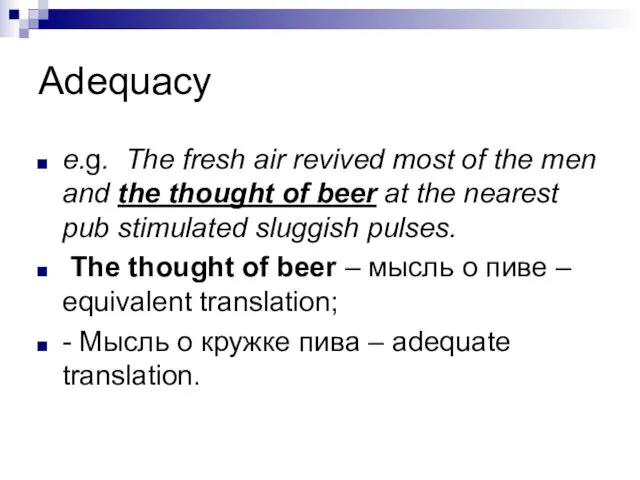
Adequacy
e.g. The fresh air revived most of the men and the
thought of beer at the nearest pub stimulated sluggish pulses.
The thought of beer – мысль о пиве – equivalent translation;
- Mысль о кружке пива – adequate translation.
Слайд 23

Translation equivalents
Y. Retsker differentiates:
- Absolute equivalents – this is
a case when a SL word is semantically, stylistically and emotionally synonymous to a TL word.
E.g. geographical and proper names, technical terms, etc.
Слайд 24
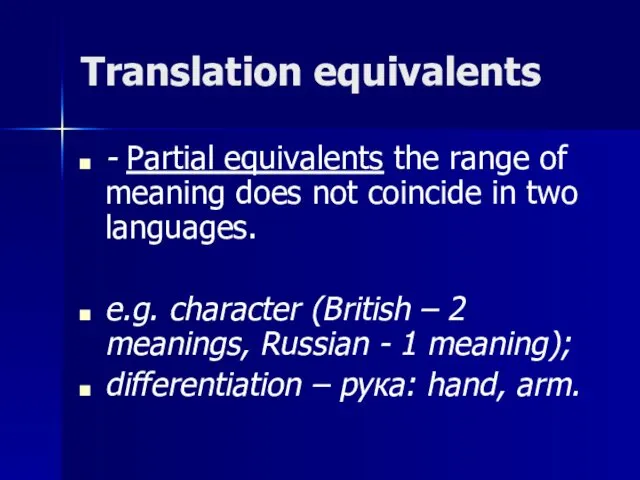
Translation equivalents
- Partial equivalents the range of meaning does not coincide
in two languages.
e.g. character (British – 2 meanings, Russian - 1 meaning);
differentiation – рука: hand, arm.
Слайд 25
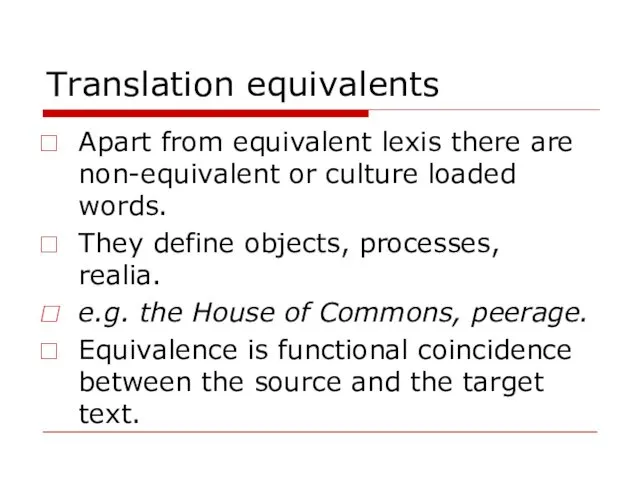
Translation equivalents
Apart from equivalent lexis there are non-equivalent or culture loaded
words.
They define objects, processes, realia.
e.g. the House of Commons, peerage.
Equivalence is functional coincidence between the source and the target text.
Слайд 26
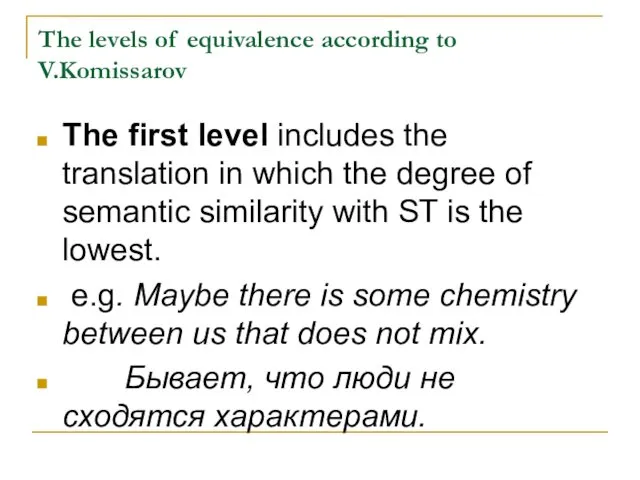
The levels of equivalence according to V.Komissarov
The first level includes the
translation in which the degree of semantic similarity with ST is the lowest.
e.g. Maybe there is some chemistry between us that does not mix.
Бывает, что люди не сходятся характерами.
Слайд 27

A rolling stone gathers no moss.
Кому дома не сидится, тот добра
не наживет.
That’s a pretty thing to say.
Постыдился бы!
Слайд 28

The levels of equivalence
This translation contains information about the general intent
of the message and it is called-
1) The purport of communication- general intent of the message, its sense, orientation towards a certain communicative effect.
Слайд 29
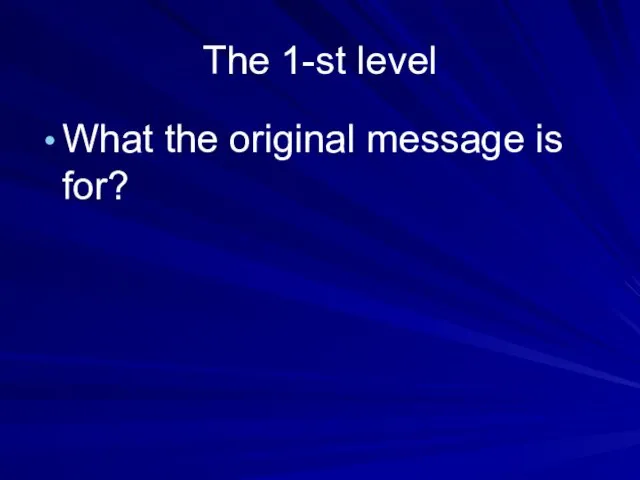
The 1-st level
What the original message is for?
Слайд 30
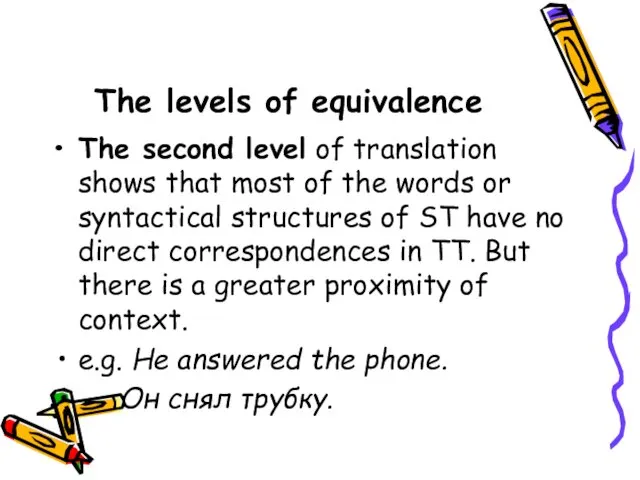
The levels of equivalence
The second level of translation shows that most
of the words or syntactical structures of ST have no direct correspondences in TT. But there is a greater proximity of context.
e.g. He answered the phone.
Он снял трубку.
Слайд 31

You see one bear, you have seen them all.
Все медведи похожи
друг на друга.
It was late in the day.
Близился вечер.
Слайд 32
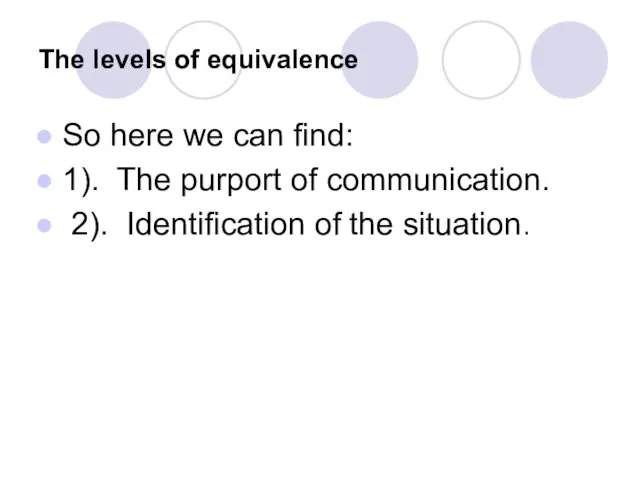
The levels of equivalence
So here we can find:
1). The purport of
communication.
2). Identification of the situation.
Слайд 33
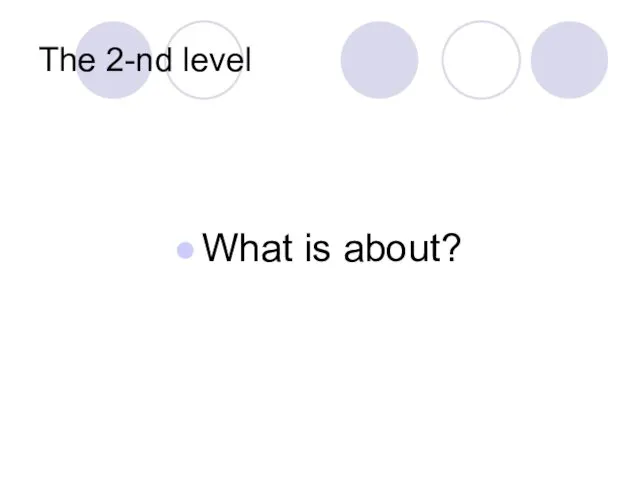
The 2-nd level
What is about?
Слайд 34
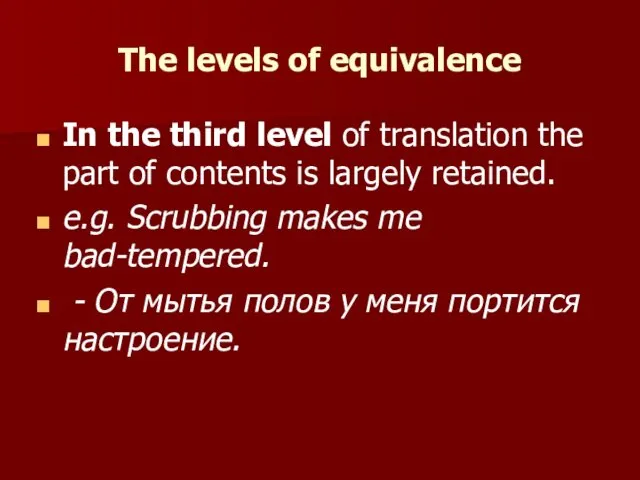
The levels of equivalence
In the third level of translation the part
of contents is largely retained.
e.g. Scrubbing makes me bad-tempered.
- От мытья полов у меня портится настроение.
Слайд 35
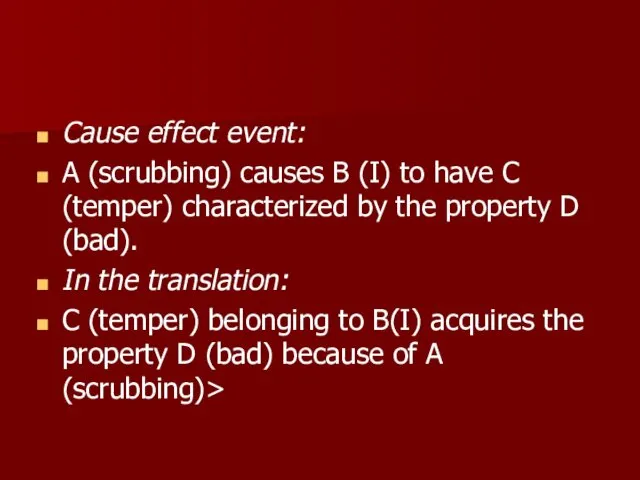
Cause effect event:
A (scrubbing) causes B (I) to have C (temper)
characterized by the property D (bad).
In the translation:
C (temper) belonging to B(I) acquires the property D (bad) because of A (scrubbing)>
Слайд 36
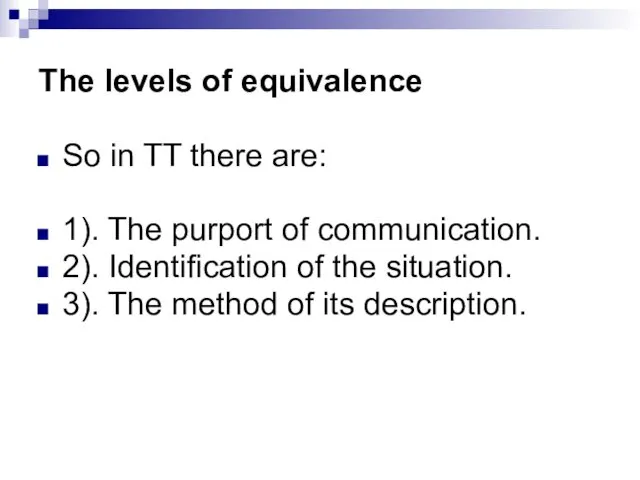
The levels of equivalence
So in TT there are:
1). The purport of
communication.
2). Identification of the situation.
3). The method of its description.
Слайд 37
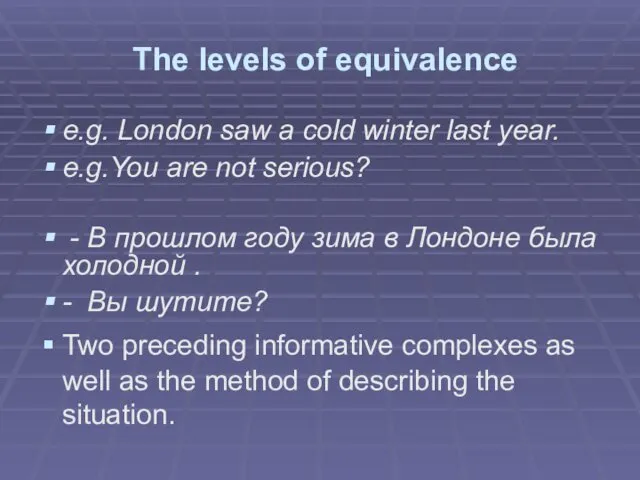
The levels of equivalence
e.g. London saw a cold winter last year.
e.g.You are not serious?
- В прошлом году зима в Лондоне была холодной .
- Вы шутите?
Two preceding informative complexes as well as the method of describing the situation.
Слайд 38
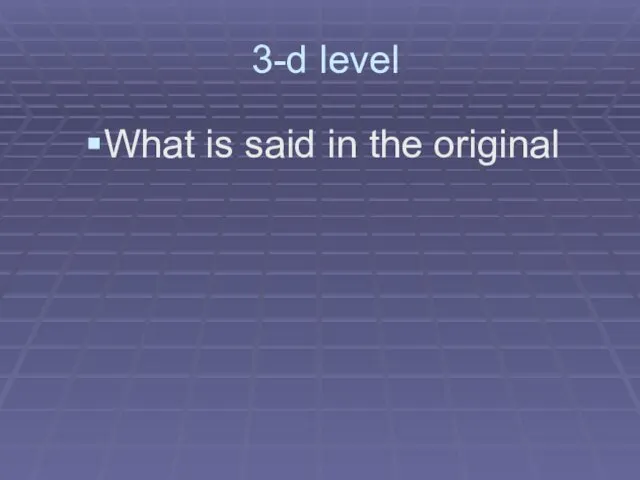
3-d level
What is said in the original
Слайд 39
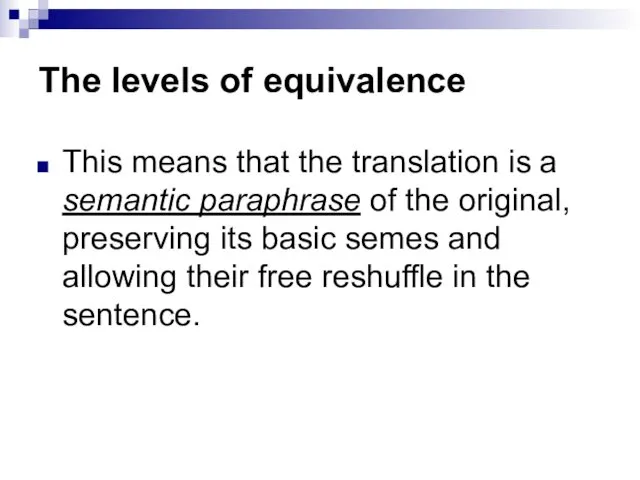
The levels of equivalence
This means that the translation is a semantic
paraphrase of the original, preserving its basic semes and allowing their free reshuffle in the sentence.
Слайд 40
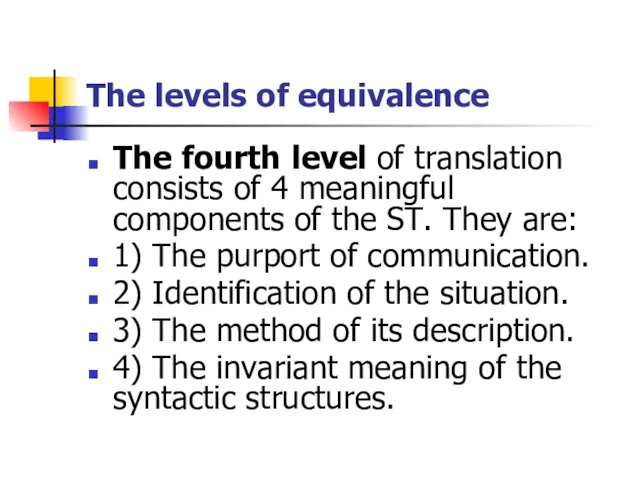
The levels of equivalence
The fourth level of translation consists of 4
meaningful components of the ST. They are:
1) The purport of communication.
2) Identification of the situation.
3) The method of its description.
4) The invariant meaning of the syntactic structures.
Слайд 41
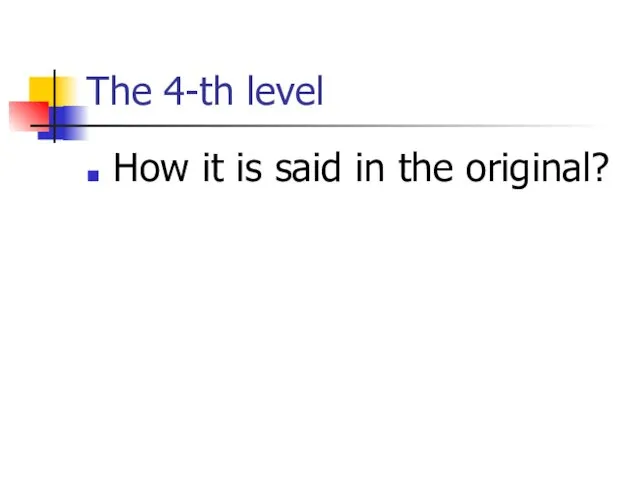
The 4-th level
How it is said in the original?
Слайд 42

The levels of equivalence
E.g. I don’t see that I need to
convince you.
- Не вижу надобности доказывать это вам.
E.g. He was standing with his arms crossed and his bare head bent.
- Он стоял, сложив руки на груди и опустив непокрытую голову.
Слайд 43

E.g. He was never tired of old songs.
Старые песни ему никогда
не надоедали.
Слайд 44
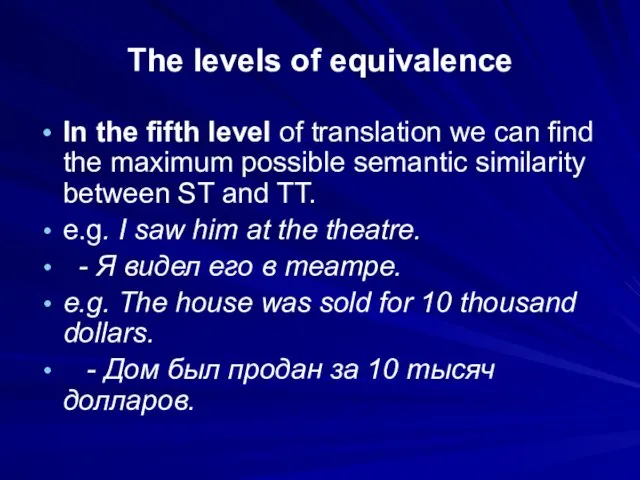
The levels of equivalence
In the fifth level of translation we can
find the maximum possible semantic similarity between ST and TT.
e.g. I saw him at the theatre.
- Я видел его в театре.
e.g. The house was sold for 10 thousand dollars.
- Дом был продан за 10 тысяч долларов.
Слайд 45
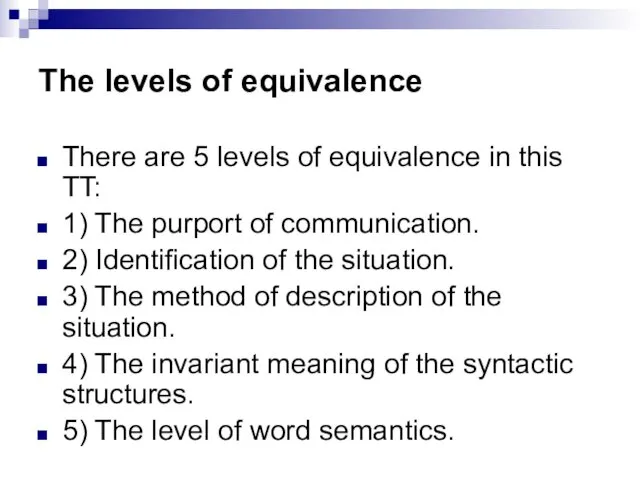
The levels of equivalence
There are 5 levels of equivalence in this
TT:
1) The purport of communication.
2) Identification of the situation.
3) The method of description of the situation.
4) The invariant meaning of the syntactic structures.
5) The level of word semantics.
Слайд 46

The levels of equivalence
E.g. the Organization is based on the principle
of the sovereign equality of all its Members.
- Организация основана на принципе суверенного равенства всех ее членов.
Слайд 47
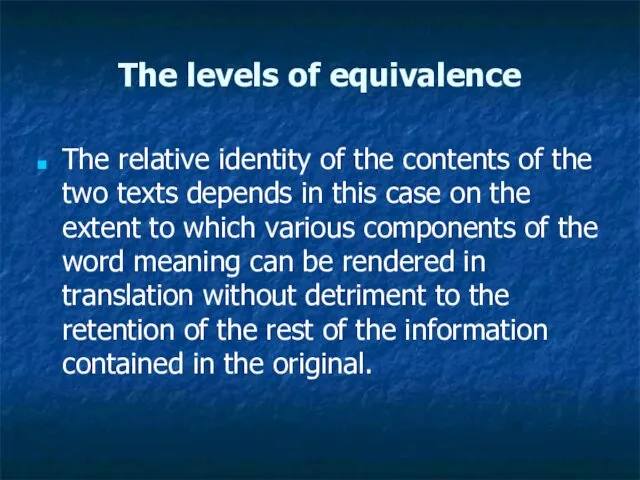
The levels of equivalence
The relative identity of the contents of the
two texts depends in this case on the extent to which various components of the word meaning can be rendered in translation without detriment to the retention of the rest of the information contained in the original.
Слайд 48
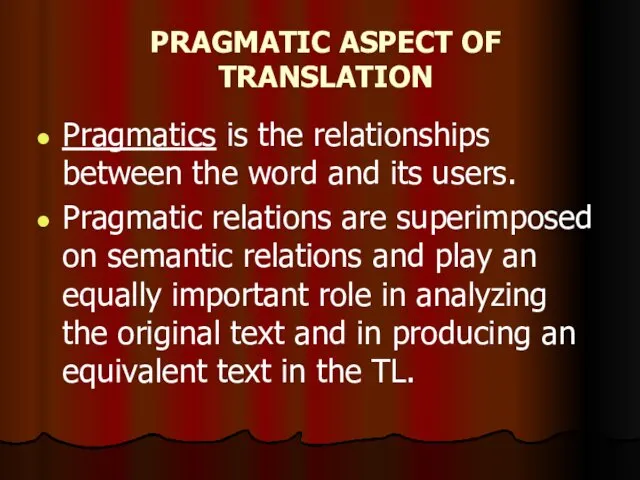
PRAGMATIC ASPECT OF TRANSLATION
Pragmatics is the relationships between the word and
its users.
Pragmatic relations are superimposed on semantic relations and play an equally important role in analyzing the original text and in producing an equivalent text in the TL.
Слайд 49
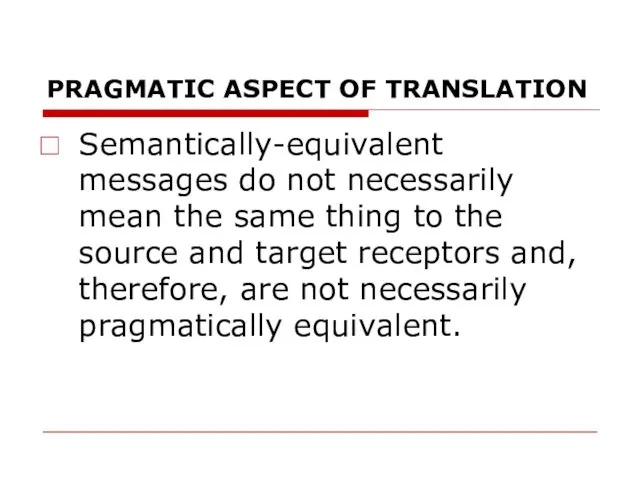
PRAGMATIC ASPECT OF TRANSLATION
Semantically-equivalent messages do not necessarily mean the same
thing to the source and target receptors and, therefore, are not necessarily pragmatically equivalent.
Слайд 50
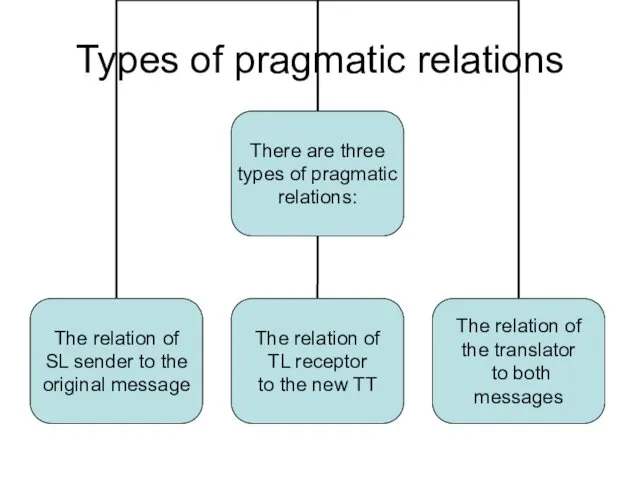
Types of pragmatic relations
Слайд 51
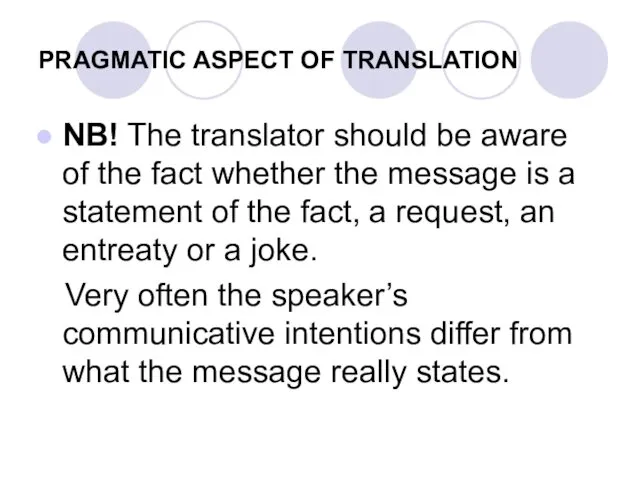
PRAGMATIC ASPECT OF TRANSLATION
NB! The translator should be aware of the
fact whether the message is a statement of the fact, a request, an entreaty or a joke.
Very often the speaker’s communicative intentions differ from what the message really states.
Слайд 52
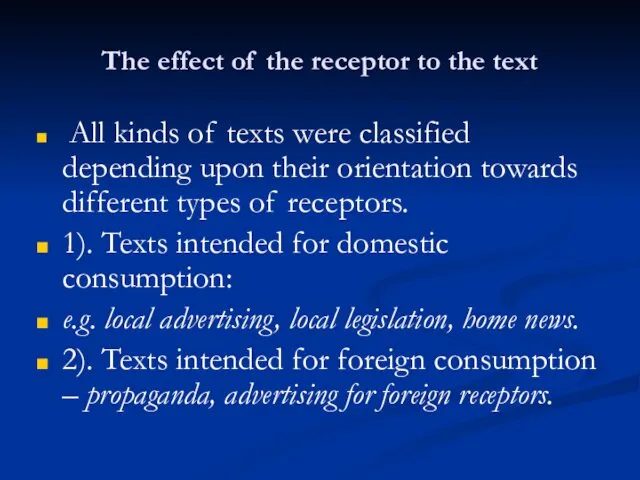
The effect of the receptor to the text
All kinds of
texts were classified depending upon their orientation towards different types of receptors.
1). Texts intended for domestic consumption:
e.g. local advertising, local legislation, home news.
2). Texts intended for foreign consumption – propaganda, advertising for foreign receptors.
Слайд 53
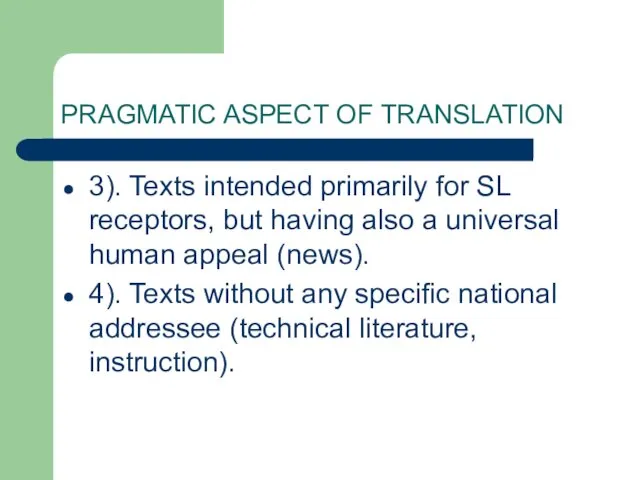
PRAGMATIC ASPECT OF TRANSLATION
3). Texts intended primarily for SL receptors, but
having also a universal human appeal (news).
4). Texts without any specific national addressee (technical literature, instruction).
Слайд 54
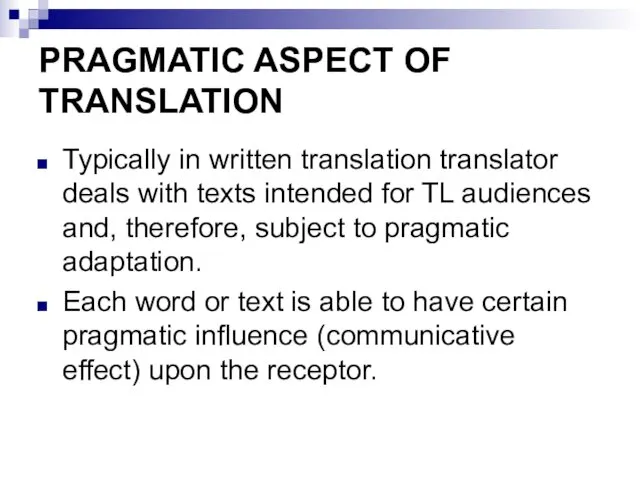
PRAGMATIC ASPECT OF TRANSLATION
Typically in written translation translator deals with texts
intended for TL audiences and, therefore, subject to pragmatic adaptation.
Each word or text is able to have certain pragmatic influence (communicative effect) upon the receptor.
Слайд 55
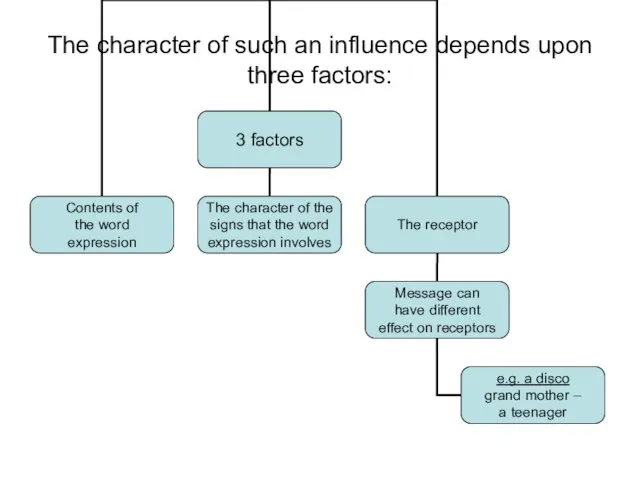
The character of such an influence depends upon three factors:
Слайд 56
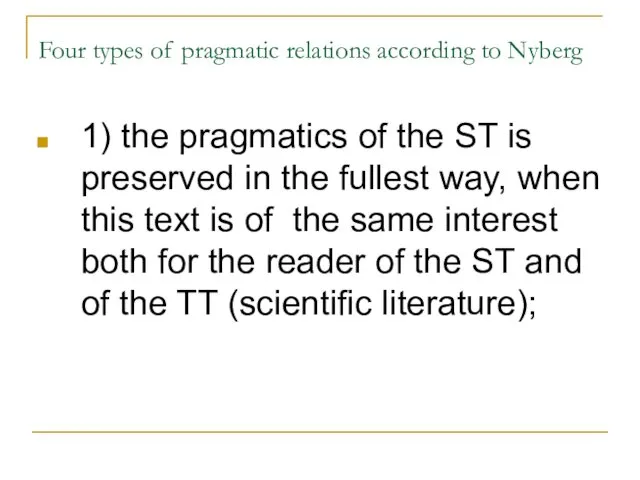
Four types of pragmatic relations according to Nyberg
1) the pragmatics
of the ST is preserved in the fullest way, when this text is of the same interest both for the reader of the ST and of the TT (scientific literature);
Слайд 57
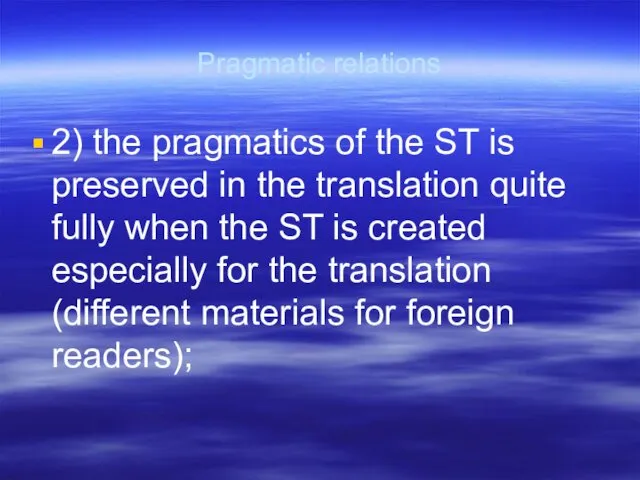
Pragmatic relations
2) the pragmatics of the ST is preserved in the
translation quite fully when the ST is created especially for the translation (different materials for foreign readers);
Слайд 58
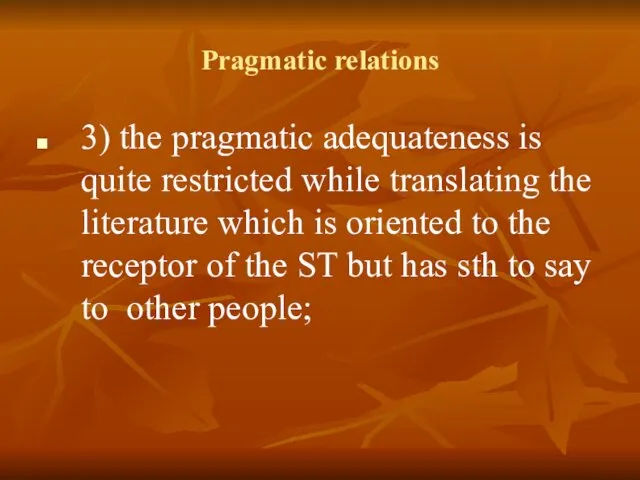
Pragmatic relations
3) the pragmatic adequateness is quite restricted while translating the
literature which is oriented to the receptor of the ST but has sth to say to other people;
Слайд 59
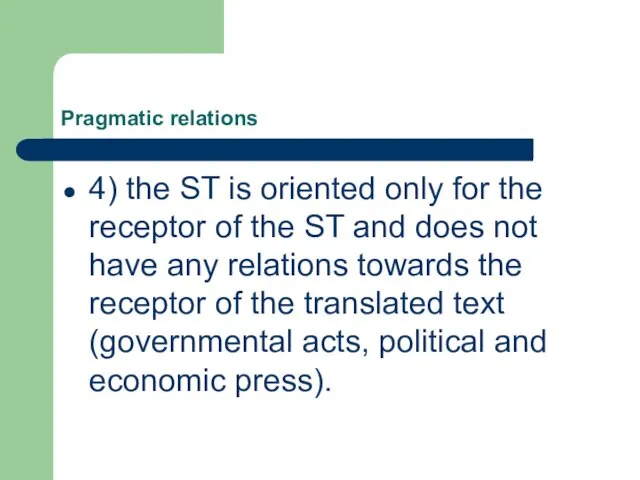
Pragmatic relations
4) the ST is oriented only for the receptor of
the ST and does not have any relations towards the receptor of the translated text (governmental acts, political and economic press).


























































 Learning to write letters
Learning to write letters What are they advertising?
What are they advertising? Things to do. Chall-2
Things to do. Chall-2 A landslide
A landslide Спряжение глагола to be
Спряжение глагола to be To speak one's mind
To speak one's mind Shanghai Cooperation Organization (SCO)
Shanghai Cooperation Organization (SCO) Modal Verbs. Модальные глаголы в английском языке
Modal Verbs. Модальные глаголы в английском языке Democratic and authoritarian political systems
Democratic and authoritarian political systems Финансовая грамотность в английском языке
Финансовая грамотность в английском языке The history of Russian cinema
The history of Russian cinema Британская пресса об отмене крепостного права в России
Британская пресса об отмене крепостного права в России Christmas presents
Christmas presents When’s your birthday?
When’s your birthday? Fifty years of pop. Grammar
Fifty years of pop. Grammar Quiz furniture
Quiz furniture Разговорная лексика
Разговорная лексика Present continuous. Game
Present continuous. Game The rainforests of the sea
The rainforests of the sea Easter questions
Easter questions English for Business Communication
English for Business Communication My family
My family Эссе. Задание 38
Эссе. Задание 38 Gerunds and infinitives
Gerunds and infinitives Conditional clauses. Type 2. Game
Conditional clauses. Type 2. Game Приветствие, прощание
Приветствие, прощание The things I love about Britain
The things I love about Britain Do and make collocations
Do and make collocations